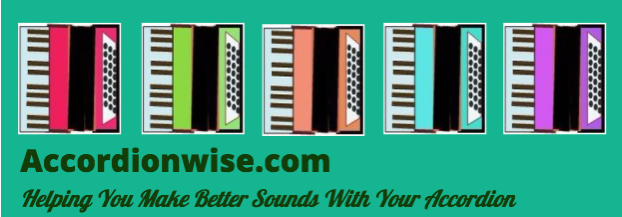I HOPE YOU ENJOY THIS WEBSITE
My name is Alex Govier, a professional musician on accordion, piano and organ for over 50 years.

On this website I am sharing stuff to
- Improve your technique
- Help you get to know your instrument better
- Play more easily and more confidently
- Try new accordion bass methods
- Integrate bass and treble sounds in different ways
- Learn how to make better music
- Gain popularity with general music listeners and not just fellow accordionists.
And yes, ALL CONTENT ON THIS WEBSITE IS FREE.
Simply because I would like more general appreciation of this wonderful instrument.
Because by playing a little more thoughtfully we can reach new audiences and get more recognition.
Find when there is new stuff on this website by joining our new Facebook Community
Here you can also
- interact with this website on Facebook
- Ask questions
- Request more detail on an accordion subject
- Suggest a new subject
- Tell us your own ideas and more.
The Accordionwise Friends link
You can find my personal playing sites on
Find out what is new Accordionwise and on this website
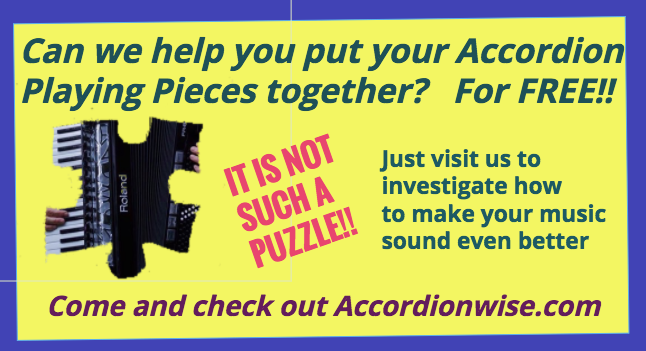
My Latest accordion playing ideas
I suppose one of the reasons that I have put this site together is to raise the status of the accordion from a successful tune bashing device to that of the real musical instrument that it is.
I even have musical friends who take this attitude, whereas the accordion can be a more expressive instrument than even the piano if extra thought is applied while playing it.
Simply playing extremely old and outmoded tunes is not the answer though, if you happen to like them and you are entitled to, applying ideas I am promoting here can definiitely even change these into something worth listening to.
The answer I believe is in really listening to and adjusting your own playing instead of just playing on automatic. In other words to play more musically, just as other instruments expect to be treated.
Accordionwise.com is a constantly evolving site. Below I will try to alert you to the latest additions to what we have here.
There are many things I would like to add that will take time and need working out how to do it best, such as adding inline audio for music examples, perhaps a video page or inline video.
Meanwhile there are so many accordion insights that are occurring to me and crossing my path and that is currently taking all my time.
Our New Accordion Quiz Page

This is designed to both test your knowledge of accordion playing, currently with in depth questions about bass button configuration. The answers will be available question by question and the act of answering them will further lodge the info in your mind ready for retrieving to get to exactly where you want to go on the bass keyboard when you are playing.
Blog Section - Latest Insights
Every morning I try to set aside an hour or two to practise and let my Victoria accordion tell me things.
This morning I found myself thinking about and trying these eight things. It also of course reminded me of what I have previously worked on or known and have posted already.
One:
Extra simple rhythm modification with alternating bass notes (not note to chord). For example if otherwise sticking to a very basic note chord chord waltz sometimes inserting (probably on every fourth bar) one of note chord note leading to the next note chord chord standard accompaniment pattern. The extra note would normally be the alternate note (G with a C chord) to lead back on to the key note (in this case C) for the next bar.
I am simplifying your following this by using N for standard bass note N in italics for the alternate bass note. I use K for Kord rather than C for chord as you would always tend to identify it with the actual chord of C which is not always going to be the case. I could perhaps have used Ch instead but it would tend to change the spacing of the letters. My excuse anyway.
So you would have NKK NKK NKK NKN straight on to the next NKK for the next phrase.
For a simple four time this would be NKNK NKNN repeated
Two
Rather than keep to the normal relationship of a Note on the main beat and then a chord on the offbeat I sometimes reversed these, particularly on the last couple of beats in the bar so the bass did not sound like a keyboard that had been left playing itself on automatic. And it sounds less doggedly intrusive. But I kept the rhythm going.
You can be quite free like this, mixing them up almost at random, provided you can come back to first beat with a note on the next bar, or even the alternate next bar. The rhythm feel therefore has to be inside you instead of attached exactly to the fingers for you to be able to do this of course.
And if you have been plugging away on a complicated repetitive bar even modified like this for very long it can actually sound nice and more relaxed for your listener if you revert for a while to the most basic NKNK style pattern, perhaps where the tune goes to a new area.
Three
The easiest choices for any additional non standard bass notes in the accompaniment. If you want more variety in your arrangements I would suggest interpolating a not too intrusive 6th to the chord A for the C chord where you feel the major third on the counterbass E for the C chord is over used or over intrusive. This is particularly natural to do if the alternative note G for the C Chord is played first and you can even go into half beats or divide the beat into triplets returning to the note next door.
This note is very obviously situated as the alternate note up from the alternate note G if the C chord but as this may lead you away from the key centre it is good to learn the counterbass version A from the F chord which is at least equally handy.
Four
Reminding myself about the bass "rolled" effect. This is an effect of doing NKN or even NKNK or even NKNK inside one beat. Gives emphasis, such as on the fourth or first beat of a tango. It is like doing a fast trill but between the bass note and chord instead of between two notes.
Five
The alternative to using just bass notes or a mix with notes AND chords is of course to only use chords. You can do this for an extended period or slightly easier for half a bar or even on a single beat by dividing momentarily into quavers (eighth notes) or triplet eighth notes, or even 16th note semiquavers.
If returning quickly to your start chord you can get away with almost any other chord as it is too quick to alter the harmony but in order to particular avoid changing the key (adding or subtracting sharps or flats) here are some guidelines.
Staying within adjoining keys is fine although you will get less interesting results in one sense. For example using either major or minor chords C F C or C G C will see no change of key signature. However from major to minor chords does change things, the minor chord pulling you down with a flat or lost sharp to the key from the button below (subdominant F from C for example).
More interesting again is when you move further apart when to stay in the same key you need to go from major to minor or vice versa, example C to Dminor, C to A minor, C to E minor, but no further, not that you would find it convenient to stretch any further. The actual notes which make up the chords will be those which can be found within the range C up to B natural because of the way the accordion is made so not all changes will have similar note shifts.
Example C to G gives you (from bottom note upwards) CEG then DGB (the top note jumps), whereas F to C gives you CFA to CEG (middle and top notes slide), or G to D means DGB to DF#A (ditto). If you try incorporating 7th chords the notes added for the 7th will affect the result (but the 5th because it is not used no longer affects it) so G7 to C will give you a rather unmelodic FGB to CEG (technical term false relations) whereas F to C7 gives you a nice CFA to CEBb.
I myself find this stuff fascinating but do feel free to yawn at this point, there is easier to grasp stuff ahead.
Six
The importance of operating the bellows thoughtfully for the bass section as well as for the melody line. Particularly where the bass temporarily is doing more than the treble or taking over a phrase from the melody.
Seven
Making wide ranging arpeggios sing out effectively. I thought my arpeggios even when fingered well and staying within the tempo were sometimes inaudible.
So first I realised that in order to keep the tone light I was easing up on the bellows so the ear was not able to follow the notes up into a different vocal range as it were.
So I deliberately maintained and even increased bellows pressure through the arpeggio.
Secondly though the arpeggio was probably being obscured by the bass part. So I stopped the bass while the arpeggio was in progress. A maximum of a shortish application on the main beats of the bar, or even more so playing the bass only on the first and last note of the arpeggio, or even only after the last arpeggio note.
Eight
The importance of tonal beauty. My realisation that a beautiful sound is my first priority and that by considering the register I was using to be rich and beautiful it followed my thoughts by becoming so. This was because of the extra attentiion I paid to it with phrasing, suitable choice of staccato and ultra legato and of course the bellows.
Some further points occurring to me with this morning's practice
One:
Blurring or obscuring of treble parts by the bass.
I previously mentioned the desirabily of stopping the left hand during wide ranging arpeggios to allow them to shine out unhindered but this may also apply in other cases.
If executing fingered chromatic slides or other ways of joining up successive notes (usually difficult to notate as taking up NO time out of the bar) these will sound better totally alone. This is of course another instance of the more general principle of not obscuring fast passages (in either hand).
BUT a full chord glissando in the treble seems to me to often sound good over just a held chord button.
AND you should be able to slide between different or even differently shaped chords if you hold strongly the feeling of playing the new chord on the way up. Difficult to imagine how it works, but if I can do it, you can too!
GENERAL PRINCIPLE which allows this is PREPARATION. As a musician you have to live in both the present and the future at the same time!
Two:
Playing chords alone.
Playing chords sustained without a bass note is a nice light effect which can feel difficult without the bass note played to judge its position. BUT you can put the note button down partially so it does not sound (and keep the standard fingering) or release it so fast that it does not get in the way (but hold the chord!).
AND DO NOT FORGET regarding the chord as your held note and dotting in stacatto basic bass notes with the tempo. The opposite way you usually regard the relationship of the note and chord.
GENERAL PRINCIPLE The automatic allocation of fingers to the functions of the bass music which allowed you to start playing so easily can be modified later without losing the original system
Three:
Emphasis of a few of the notes of the music can be done in two different ways to allow them to stand out.
EITHER play sections (such as one or two notes of crotchet eighth note triplets) with right and left hand simultaneously, with chords most likely played in both right and left hands
OR leave out the left hand altogether in lighter instances of emphasis to allow the right hand notes to show
Four:
Showing the structure of the music helps listeners appreciate it.
You can do this most impressively by changing the way you use your accompaniment left hand during one of the sections, such as the chorus or the middle eight.
WHAT IS THE MIDDLE 8? That is the few (normally eight) bars in the middle of a tune that you do not know so well because it is different (in a new tune, the part you should practice separately so that it does not startle you and make you falter when you have to get to it!)
This may also be done to a lesser extent by varying the register you are using. WHAT AN IDEA you could even do both at the same time. BUGBEAR You need to be able to come back to the orignal setting and/or the original bass styling.
More points occuring to me as I practice or meditate
One
It occurred to me it was time I put down on paper something about syncopating, which is really reallocating note values in a tune to suit your interpretation, avoid wooden-ness and exact matching from right hand to left hand which can sound very uninspiring. It also occurred to me that this might be the best way to "play like a top singer" such as Sinatra, rather than as a basic accordion player.
The basic principle of syncopation is that the notes do not appear exactly in the normal places within the rhythm, mostly appearing early, just a fraction before the beat they are supposed to be on.
That frees up the rhythm and lets the player interpret instead of just slavishly following the arithmetic on the printed page.
Here is an example and more notes on using it you will find HERE. But basically you should make sure as well as speeding up previous notes to get in early on your target syncopation that this does not disturb the tempo of the left hand.
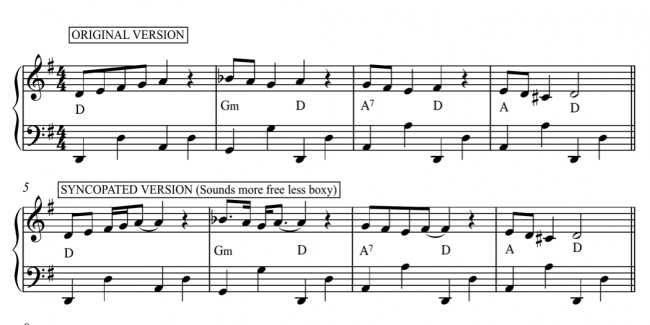
The second line amy look a little complicated but there are two main things to rememver.
ONE- You can see where the syncopated part is going to be ahead of its expected timing in the written music on the second line aboce
TWO - The left hand plays very steadily as usual and makes no attempt to catch up with the syncopation by playing early!
More on this .. extended version
Two
A corollary of this is that a tune can sound more free flowing if the left hand and right hand, though both basically in tempo, are almost disconnected, with very few places where they are sounded simultaneously.
This sounds silly and impossible but there was a British jazz pianist whose style very much exemplified this.
Three
Occasional shorter (quickeer) note values in your bass section help your bass accompaniments sound more alive without that boring note for note matching which kills accordion music for the normal music listener.
This would be in the form of extra notes such as triplets NKN or KNK or even NNN or KKK inside one of the beats, instead of the more normal single note or chord. And obviously without disturbing the basic pulse of the music.
This I feel is most likely to be effective at the end of a bar, or even reserved to the end of a phrase to link easily to the befinning of the next phrase.
Four
The idea to go between chords without an intervening bass note is an interesting and subtle sounding idea. This is indeed especially usable if you are using them inside a triplet, since however strange the chord you happen to hit as the second chord it will not disturb the overall harmony, since you will be returning to base each time on the third chord when working KKK.
However an easy interpolation is to go to the chord directly below such as CFCor just missing one chord to go to C Bb C is very nice and almost as easy.
I would recommend going from a minor chord to the minor chord below it as in Cm Fm Cm or to the Major chord two buttons away Cm Bb Cm is pretty smooth
But as I say if you hit something more obscure by accident it will sound like you are being extra deep with your choice of chords and will still not disturb the overall harmony.
I already mentioned the usefulness on the fourth beat of the bar (or third when in waltz time) ot for linking to the next bar
Five
For people who think they are at their maximum speed playing only one note or chord to a bar if you keep a desperate kind of holding down strength when playing bass buttons, (same thing for treble notes also), it prevents you playing the next note very soon. Do not get too attached to the note you are playing, you have other places to go, so just play it lightly and shoot off to the next part of your musical journey
Six
Remember that there are other ways of avoiding blocky playing, such as to leave bass notes out deliberately or play extended background chords over several beats. Although a long chord added to a melody note can be quite a heavy effect, it is lightened the normal way by decreasing bellows pressure. The melody note will sound stronger because it was played at a higher level initially.
Some thoughts from today's practice. Divided into two main areas.
One
I have been trying a few standard fastish tunes on which quite basic bass patterns are OK, providing, in my view, that the following points are taken care of
- Make sure that the bass line does not obstruct important faster tune sections. Stop where neceessary for a few notes. Always stop when the following phrase of the tune starts AFTER the first beat of the bar.i
- Occasionally a quick "roll" - i.e. NKN in a one beat triplet can keep things moving, phrases connected or simply provide relief from the basic sound
- Unless you want a different feel chords CAN be played short but are probably best connected with the bass note before them, presenting as a single unit the note and the chord following. They do logically belong together in the harmony.
- Even in an alternate bass and chord pattern there is still scope for a meaningful bass note progression, such as going down one semitone at a time. When doing that it is best to play a full legato bass so the ear can hear what is happening, i.e. that both the bass note and chord are moving logically.
- Breaking up the repeated pattern between phrases with little bass note runs joining two different notes of different chords is also possible of course
Two
- The chords played in the left hand and right hand do not have to be the same.
- They may not clash but instead build up to make a richer chord not seen as possible with just a cursory glance of the stradella button system.
- They may clash but in a passing form with the clashing chord coming first then resolving onto a more settled form or the right hand can shift onto an apparent discord after a more seemingly peaceful start.
- You can even have a series of discords making limited sense until eventually settling onto a peaceful resolution which justifies them. Starting from a discord or otherwise. They may for example be sliding chords in the right hand (which obviously would not be very practical in the left hand)
- When playing like this they should be played together without apology or shortening of either part of the chord to spoil the effect. This effect is intended to be heard, otherwise it is not worth doing.
- The effectiveness of this may vary, depending on the area of the treble keyboard used, the bass and treble registers selected or even the quality of the instrument and particularly the richness or otherwise of the bass reeds.
ADDENDUM: I just went back to playing my accordion again and on the lines of the last suggestions I tried holding a simple major chord in the bass while outlining a melody in next door thirds, mostly but not all inside the key signature. Sounded sensational, slightly western/Mexican definitely a good accordion sound (possibly safest with the accordion register LMM). Then full chords against the bass including ones just a semitone away. I kept the bass chord sustained and occasionally punctuated it with easy bass notes, to push it along, such as on beats 4 and 1.
Try it and enjoy. Think again about whether it is necessary to match every chord between treble and bass, you will often sound more musical and smoother only doing the main (and easy!) changes.
My insight this morning from practising was principally this. As I am always endeavouring to produce a sound which is meaningful, flowing, and easy to follow for listeners I came up with this.
To give maximum freedom to the tune to be played in its best interpreted form maybe you should divorce it to a certain extent from the left hand accompaniment pattern.
The rhythm in the left hand of course needs to be rock solid and it requires a solid feeling inside of that rhythm, not just one which is reliant on habit. (Even that can dodge the odd note or chord out of the way of the tune, but be careful here!)
While not every note in the right hand should be right on the clockwork beat and coincide with the matching place in the rhythm but be where a good singer might place it, using the accompaniment as a guide rather than as an imprisoning anchor.
This improves the flow, relieves congestion of notes colliding thus making all parts easier to hear for the listener, and of course gives maximum interpretative power to the melody.
It can even be employed to free up the exact location of runs in quavers (eighth notes) making them easier to hear if continuing the bass while doing them. You will probably already have read my suggestion that in most cases the bass should be ceased totally as competition for such runs, but this is a viable alternative to avoid doing the same thing too often which is a listener annoyance perhaps.
Jazz players probably do this instinctively, (but for those who don't maybe another reason for playing with a rhythm duo or trio). My hero Frank Marocco was one of course who would also gladly work independently.
I realise this goes totally against the way you were first taught to play, but all the good tips which make you sound better do!
At first you may want to try this while keeping the first beat of the bar where it is "supposed to be" but as you get better you will be able to place the melody note around even there exactly where you want.
Remember the idea is the bass and treble parts can be INDEPENDENT. It is a wonderful feeling of freedom if you can do this and will improve your overall sound and add distinction to your playing.
Oddly enough I think this will make your music more pleasant to listen to and understandable by the most basic listener, and we should always be playing for them, if only for commercial reasons.
Sorry if this sounds obscure. I know I should be illustrating this concept, but maybe later.
Thought for today
Finding the relative minor chord easily by subsituting the minor 7th, eg going to Am from C. Em from G. Dm from F, Gm from Bb etc is easy by substituting a minor 7th. This is done by simply adding the relative minor name note as a bass note and so using a minor 7th instead instead of the basic minor chord.
OK I know we cannot play minor 7ths in the bass chords because there is no row for it, major, minor, 7th and diminished yes, but no minor 7th chord. So this is definitely worth noting
How? STAY WITH THE MAJOR CHORD and add a note which will be the new root of the chord from the counterbass. Be sure to play the new note and original chord together at some point so that it registers on the ear as a chord and not two unconnected items.
For example to play the sequence G G chord - E Em chord - A Am Chord - D Dm chord just subsitute Em7 Am7 and Dm7 for the basic minor chords. BUT HOW?
What you actually play is G G chord - E (counterbass) G chord then sounds as Em7 - A (counterbass) C chord sounds as Am7- D (counterbass) F chord sounds like Dm7.
This is possibly difficult to initially think about but easy to actually do. The counterbass note used is pretty close, it belongs to the chord below on your stradella keyboard.
NB You could also regard these new Minor 7th chords as 6th chords, depending on the context. For example G minor chord is G Bb D F, while B flat 6 chord is Bb D F G. And a Bbm6 chord or Bb Db F G can be played from the Bbm chord button with the extra G added in the bass (The G bass note comes from the counterbass of the chord below in case you had forgotten)
Thoughts for today
There are Many ways to use just the three basic notes and one chord in a bass pattern.
If you Add the note above in counterbass or even easier the 7th only 2 buttons below in basic row and there're even more
The variations can be between different orders of playing the single notes or even reversing the places where you would normally play the note to put a chord there in the pattern.
And if you have done a lot of variations a simple alternate note and chord will relieve stress for a bar or two and becomes a variation itself!
You could even try a chord shift and back with no bass note between instead of extra notes when playing in quavers (eighth notes)
The most obvious ones either side chord do work but are not as smooth as missing a chord to the next tone up.
Going between major and minor alternate or two notes apart ones such as between G and Am or G and Dm are nice and are smooth as it keeps you in the same key (no accidentals) and it creates shifting melodic movements from the notes within the chords.
The effect will not be the same in all keys because the chords are produced from the same sets of reeds between C and B so it is not the case that they are all root position or otherwise.
The basic root position will apply between the chords C to E (that is to say for C, C#, D, Eb, and E), 2nd inversion from F to G (F F# and G), first inversion from Ab to B (Ab, A and Bb)
Remember that all the rhythm need not be expressed in the bass if you are adept at playing chords and mini arpeggios in the right hand under or above the melody line.
You can also get lovely full moving patterns by going from chord bass to chord in right hand and a nice texture if they are overlapped.
CHANGING THE SUBJECT A LITTLE
Awkward gaps in the tune can be filled EITHER by an enhanced bass pattern till it starts again OR by a right hand run towards the starting note of the next phrase.
Such as a normal or chromatic run or chord based figure or your inspired combination of such.
Or even use a twiddle around it before it starts, eg starting note G lead into it with quavers GAGF# G.
In either case break off the bass while doing this, always a good way to add fluidity to your playing and therefore listener appeal.
Fellow accordionists will make allowance for the limitation suggested by the format of the instrument while general listeners are more impressed by an arrangement which would sound pleasant and flowing on any instrument.
Right Hand chords
There is already a section on sounding good by playing different chords in right and left hands on accordion, but it occurred to me today how I might make the subject a little clearer, using of all things, a little music theory!
Some people are hazy about playing right hand chords anyway on accordion. Why should they learn that when the left hand buttons make the chords for them automatically? If you are already fine with right hand chords skip to here.
Chords are made up of piles of alternate notes (thirds)
For those that don't know the root position chords are of course alternate notes (thirds as we call them for skipping over one name note, eg A (B) C, so A and C together make an interval of a third.
Basically all you have to do is play alternate notes on the piano style keyboard, but beware as some have extra black notes between them and some do not. If you choose to go ofrom A to C#you have covered a major interval but a minor one from A# to C#
The basic rule is that while the outside of the root chord stays the same distance, there is a spare note wavering around in the middle which could be either a sharp or a natural or a flat or a natural. So where should that be?
How to work out which is major and which is minor.
Very simply put a MAJOR chord has a MAJOR 3rd then a minor 3rd on top, whereas a Minor chord has a Minor interval first and a great fat Major 3rd sitting heavily on it!
So if you count the notes you play upwards 1 - 5 -8 is Major (eg F major chord is F A C )whereas 1 -4 - 8 is minor (Fm is F Ab C).
Once you have the correct root position chord the notes can be in any order (different inversions) so A C F or A C F are still fine and actually may sound better with the left hand part of the chord. Don't try F C A with one hand obviously unless you have massive hands (or come to think of it a amall-scale keyboard)
Once you have the basic chord, the one you are already bored with and think they are the only ones you can play life starts getting interesting.
So let's start making some interesting sounds
Let's start with a simple major or minor chord as the basis. Do a G major right hand chord with a G chord held in the bass as you play the notes G B D in the right hand.
Do this in a range which will have the right hand playing in a higher octave, either using the registers, or the appropriate part of the right hand keyboard. Your ear is the guide.
Now build it up
WARNING: THESE INSTRUCTIONS ARE NOT TO GO TO DIFFERENT CHORD INVERSIONS BUT FOR BUILDING UP NEW CHORDS!
Play your G bass chord again but in the right hand start with its second note B and add a third note to play i.e. B D F. Hold on a moment this is not a new chord, it is your standard G7!
!
If however you choose F# for your extra note you DO have a new chord, G with sharpened 7th and a very different harmony (G B D F#) It does no harm to still play the original G chord but as we go on you may be running out of fingers
Or if you start with G minor (G Bb D)
If you start with a G minor chord however and add F natural you are in business, you are now playing the "impossible" Gm7 chord. You can also sharpen the 7th there but this is probably less useful and possibly a dead end for building up further from.
Once you have your new chord you may like to try inverting it for a better sound (instead of playing BDF for G7 you can play DFB, or instead of Bb D F play DFBb. And also of course make sure your right hand notes are coming in a different octave (higher) than the left hand chord
Extend the system the same way
Try that again and you are going into 9ths (one note more than an octave) and an increasingly interesting area.
Go from the normal 7th (not the sharpened one which though fascinating is more or less a dead end for more development) and play either a minor D F A or diminished chord D F Ab while holding your original G bass chord.
Reminder how you got here - F bass chord against first F A C, then add E or Eb for (F) A C E or (F) A C Eb for the normal F7
Or this might be an easier explanation copied from my post today in the Accordionwise Friends Facebook page
This is based on the chord D
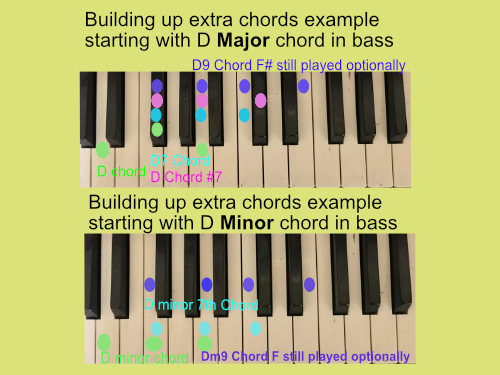
I am trying to explain my thoughts on building up more interesting chords for www.accordionwise.com blog and thought that this picture might be a start.
The idea is that you hold the basic chord whether major or minor in the bass, replicate the basic root chord (basically simply alternate notes up, making sure that you match the key signature of the chord BELOW it!!) it in the right hand, then leave out the bottom note to play an extra note a third interval above.
Notice that when you stick with the chords key signature you get the interesting DMaj7 or sharpened 7th chord.
Depending how heavy or light you want the rich harmony to sound you may use the bass note or not. But if you chicken out on holding the bass chord, you miss the whole point!
I apologise for using the D chords as an example but that happens to be where my photo for the keyboard started! Still it makes a change from C doesn't it?
You can of course go up to the 11ths, 13ths and beyond, but sometimes I feel these are better explained as 7ths on the wrong bass note! So I stopped.
What use are These chords and where can they be used?
Apart from sounding nice and richer than the basics you mean?
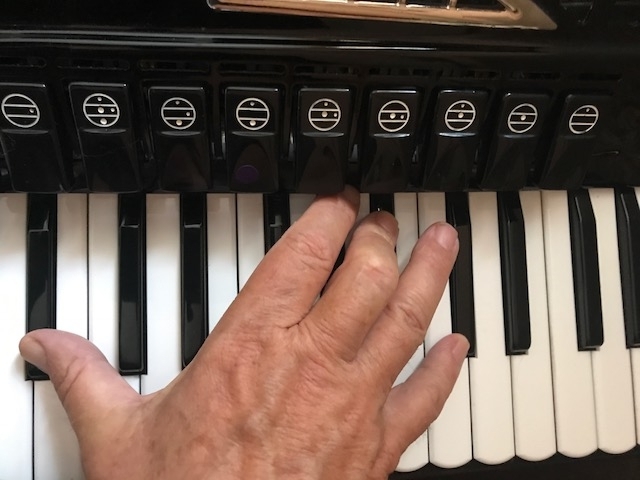
I hope you can see this. I am playing a tenth here, B flat octave B flat and top D flat. NOTE THAT I HAVE AVERAGE SMALL HANDS!
This morning I have been experimenting with right hand stretches and although I have always been interested in the note covering possibilities of smaller type keyboards I found this on my Victoria with almost the same size keys as a piano I think
The main difficulty was in taking the photo to show you, seeing that I only have two hands to do that. I hope you can see what notes are being played B flat, Bb octave and Db at the top. In fact a full 10th
.
Normally I would try this kind of stunt hanging on to the outside edge of the white keys for maximum spread but this works too. White key version would be for example A higher A and high C part of Am chord.
The holy grail realisation was that this was possible to play a 10th as long as the top and bottom note were either both white or both black.
.
Obviously I discovered that 9ths like C up to Bb and high D were a cinch or A up-to G and B easy. Again with top and bottom notes of the same type.
C Bb high D would resolve down normally to an Am chord C A and C (spelt upwards) or A with high G And B would change over to a modified D chord A F# A spelt upwards (these are only 3rds of course inferring the chords, but the bass chord could cut in to complete the chord at that point)
Just imagine what you could do if you have a reduced size keyboard (formerly known as a Ladies Model accordion)
Finger-sliding chords
My thinking this morning relates to something related to the SLIP-SLIDING post a bit back. First a new device and then further comments on the glissando mentioned earlier.
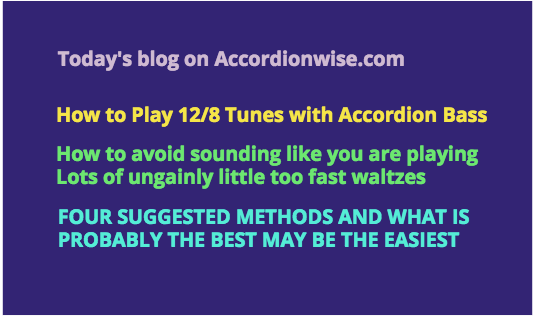
While the ideal is to avoid mini-waltzes inside the 12/8 tempo as much as possible (except for special effects of emphasis for a bar possibly) the main problem is when you make this sound the norm.
One NKK you find yourself playing at the beginning of a bar if followed by a KNK or even a NKN can prevent the mini-waltz effect taking hold.
SECONDLY if you are familiar with going down to the level of semiquavers or 16th notes these can be incorporated usually instead of the second quaver of the 1st, 2nd or 4th main beat triplets. Best not to do them on successive triplets probably.
For example (the shorter quicker notes are in lower case)
NknK NKN NknK NKN or
NKN NknK NKN NknK
THIRDLY
Pardoxically a linking bar to the next phrase of the tune can be effectively emphasised by simply playing N K N K as in the most basic form of playing giving up the triplets for a bar.
A nice rock triplet beat can be achieved with an
N(kn)N NKN NknN NNN (notes in brackets optional but the time taken to play them is not)
As in the example of the general shape
C Ck C - E Ck E - G Ck G - E G E
or even modified on the last beat with the A from the counter bass below
C Ck C - E Ck E - G Ck G - A G E
I hope this is understandable by all, done to save time writing music and to work for non-readers also
FIFTH
This extra quick movement style between alternate note and chord can be exploited nicely in other beats, spicing up beguine, rhumba, paso double even, where it puts in the movement without the spluttering reed effect normally accepted and with less strain on the fingers
later, I may even manage an audio demonstration of this. Which would be added to this part of the blog and/or part of a general page this is added to.

HOW TO PRODUCE RICH HARMONY EASILY WITH ONLY THE MOST BASIC CHORDS
I have previously put up posts about expanding chords by adding thirds on top of ones you already know how to play in the right hand but this is even easier.
There is of course one extra element to be added.
PLAYING IN THIRDS IN THE RIGHT HAND
That is to say adding an extra note two notes below (i.e. just miss one note between) your melody note. Your tune is still on top.
The lower note should conform to the key signature, so if you are playing in D and the melody note is A you will play F# with it not F natural. A natural and easy thing to do.
ALSO HANG ON TO THE STRONG ORDINARY CHORDS YOU ARE PLAYING IN THE LEFT HAND
You will not get a rich sound from the combination if you have let go of the chord which is supposed to be building up this more subtle effect. Hold the chord button while the right hand thirds move up and down against it.
THERE WILL BE DISSONANCE AT TIMES BUT THAT IS WHAT WILL ENRICH YOUR HARMONY. ENJOY IT!
You should play with sensitivity and really listening to the gentleness or accenting that can be imparted by the bellows.
Do not attempt to play more than the most basic three or four chord harmony with your thirds. The tune will be firmly anchored in the key and yet with a strange subtlety which seems to come from nowhere.
ONLY LET GO WHEN YOU NEED TO LET THE TUNE SHOW UP ESPECIALLY CLEARLY (PERHAPS PLAYING A VERY FAST RUN)
BUT WHAT ABOUT THE FINGERING FOR PLAYING IN THIRDS?
This is quite easy, particularly if you are covering four consecutive scale notes and does not even vary much when black notes are involved.
LET'S TAKE AN EASY ONE TO THINK ABOUT
CA - BG - AF - EG
will be covered by
53 - 42 - 31 - 21
You are simply using the fingers in a logical sequence for three notes and "dragging" the thumb downwards to do the fourth one EG. The thumb is the only digit that needs to do this at this point.
If you are wondering how you would continue this down, the next one down for FD would be crossed over 42. Which would be followed totally naturally be 31 for EC and 21 for DB.
But let us trace just the four note run upwards instead and show that it works where there are black notes in the key.
IN THE KEY OF E FLAT YOU MIGHT HAVE
EbG - AbF - BbG - CAb
Which is just as logically covered by
21 - 31 -42 - 53
The only modification for going upwards is to remember if you are going upwards for more than three notes you need to start by exploiting the chance to play your third with spread thumb and finger 2, in other words with 21, so you can open out with 31 next.
THE SOUNDS TO USE
To your own taste but I found this worked well with the "Accordion" voice or even better the Musette or even full Master Musette setting.
The Musette sound is possibly best lower down on the keyboard, higher for the Master to accommodate the low reed included, but if using a normal octave tuned accordion you may want to use the accordion or master voice on a higher octave.
AS ALWAYS, THE KEY TO MAKING A BEAUTIFUL SOUND IS TO REALLY REALLY LISTEN HARD TO THE SOUND YOU ARE MAKING.
IF YOU APPRECIATE IT, THEN SO WILL YOUR LISTENERS.
August 29th 2018
THE SPECIAL ACCCORDION SOUND OF PLAYING IN THIRDS

I may have mentioned this before, but here is a reminder.
Yes the sound of playing in 3rds in the right hand makes your accordion sound richer and more musical. (Normally keeping to the sharps and flats of the key you are in)
And not as difficult as you might suppose to get the fingering for it.
If you run out of fingering it is either a matter of learning how to cross fingers in 3rds to get a wider range.
Or easier find a suitable point to cut the legato playing and produce a new phrase after moving the hand wholesale!
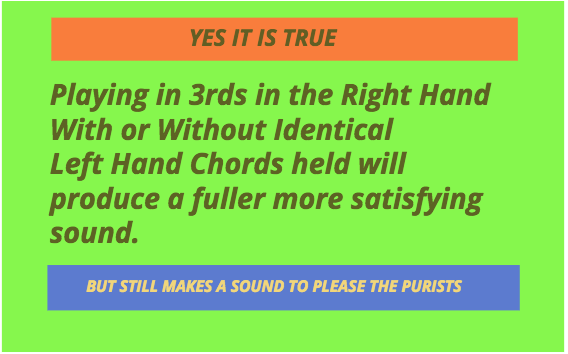
This one is another technical one I am afraid but useful. Just follow the instructions for useful bass runs.
Notice that a seven note run can be two triplets leading to the next main beat as in Diddely Diddely DUM
A five note run is a useful semiquaver on one beat to to the next main note as in Diddleiddle DUM or quavers as in Diddle Diddle DUM
I hope that makes sense to you - I think to make sense of them you should practice them in rhythm like that. Then you will get a feel for what they are useful for.
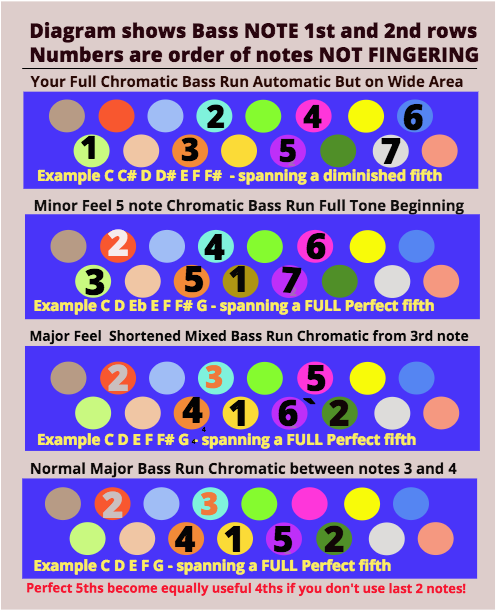
Also the two alternative positions for note 2 in diagrams 3 and 4
Don’t try using them both at the same time folks!
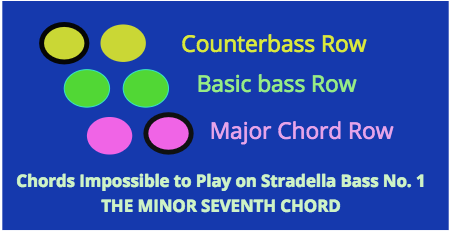
IMPOSSIBLE CHORDS TO PLAY ON STRADELLA BASS NUMBER ONE - Minor 7th Chords.
Or maybe you can! And Easily.
As shown in the diagram select your key note but play it in the counter bass, for example D (the counter bass of Bb).
Take the major chord from the key immediately above, example F
PLAY THEM TOGETHER and you have D F A C - or D minor 7th.
EXTRA IDEA
If you play F minor instead with the D you get the less usual D diminished with normal 7th, sometimes represented as D with triangle. D F Ab C.
Jazz players have a name for this which I forget. I would call it D dim #7 or possibly Dm7 b5 according to the phases of the moon.
Remember unless you have the courage to hold the note and chord at the same time instead of seesawing you will not hear these chords.
September 18th
THE NINTH CHORD
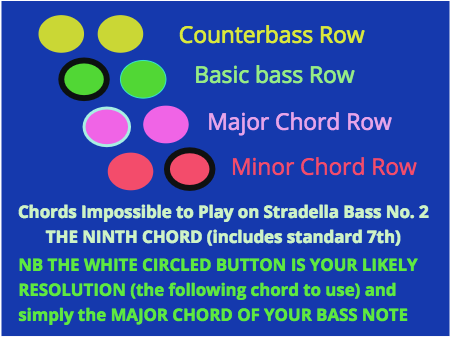
This is simply the logical follow up to the Am7 diagram just posted.
It looks more complicated than it is, because for clarity I added the minor chord row as a fourth row to look at, however the finger spacing is exactly the same as the minor 7th version, just starting on the main bass note row and not using counter bass and going across to the minor row.
Technically a discord which requires to go to a more settled state - the resolution - the following chord is likely to be simply the major chord belonging to your bass note.
I have outlined the resolution button in white
Hence very likely you will have D9 then D, or Eb9 to Eb, etc etc could not be easier.
Again, you will not hear this chord unless you play and hold the notes together. Just dabbing at the notes will not cut it.
September 20th 2018
DEFINITELY IMPOSSIBLE CHORD TO PLAY ON BASS
No. 3 THE AUGMENTED CHORD
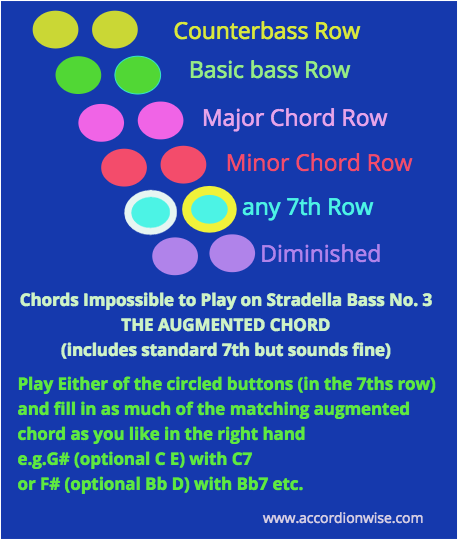
Play The 7th chord named for the augmented chord you want
Complete it with the IMPOSSIBLE augmented 5th interval
in the treble, or maybe part or whole of the augmented chord you are after.
So for F augmented play F7 in bass, and feel free to play C# or F and/or A and C# in the treble.
For G augmented use bass G7 treble D# or G and/or B plus D#
and so on
In increasingly rare circumstances this may not work (normally only with antique instruments)
You will get the normal 7th sounding with this, but this does not normally sound at all bad, just a little richer version of the chord.
CAUTION: This has to be with the 7th chord, not the major chord. Normally the 7th chord made up of only three reeds does not include the 5th that would clash.
28TH OCTOBER 2018
I tend to think that if you think your bass is too loud about half the time it is because you are ashamed of it! It is a bad, over-repetitive, simply annoying bass maybe which does nothing to advance the tune!
The idea of the staccato bass has its point in some fast playing and styles, but in the main I do not like it. Sounds like trying to avoid the point.
It also tends to make it impossible to phrase left hand notes and chords together or playing combinations of buttons faster. Because the fingers do not keep contact with the buttons
*****************************************
For a start I consider that if you are playing alternate note and chord in the bass these two belong together so are generally worth linking on beats one and two. The sound is then able build up and the bass and chord justify each other's existence in the harmony.
Sometimes the chord may feel right going smoothly to the next bass note also.
*****************************************
Sometimes bass lines can be made lighter by playing chords only (no matching bass note) or ALMOST chords only since you may feel uncomfortable finding the chord without the support of its bass note. You can in fact play the bass note WITH it initially and of course the sooner you let the bass note go, while holding the chord, the lighter the effect.
And if you hold it just a little longer you still have a light sound but with better emphasis on the strength of the harmony.
*****************************************
Putting notes where you expect chords and vice versa, chords OR notes only, sometimes in faster divisions (in eighth notes, quavers, or even triplets, plus leaving out to avoid obscuring and overdoing a faster more detailed part of the melody are also of course there for you to bear in mind
The most obvious and professional sounding leaving out, particularly for jazz players is to lead into a phrase without accompaniment at all - think Quando Quando - Do bee Do bee Do Bee DOO (the accompaniment starts on the first beat of the following bar naturally here)
Friday November 2nd
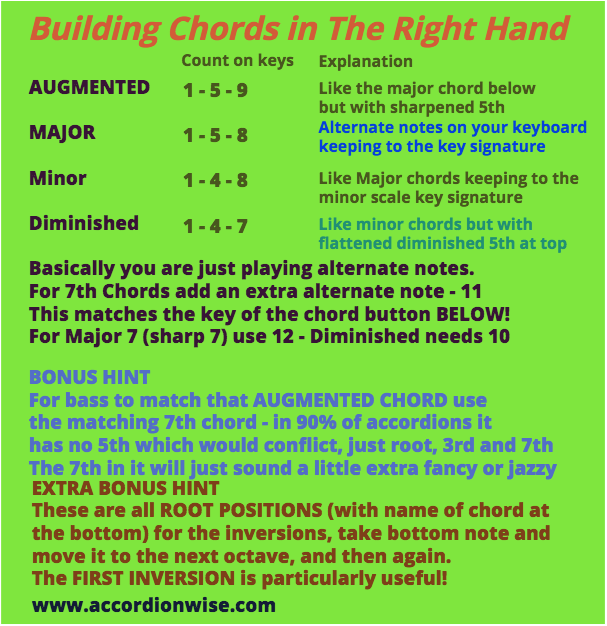
Sunday November 4th
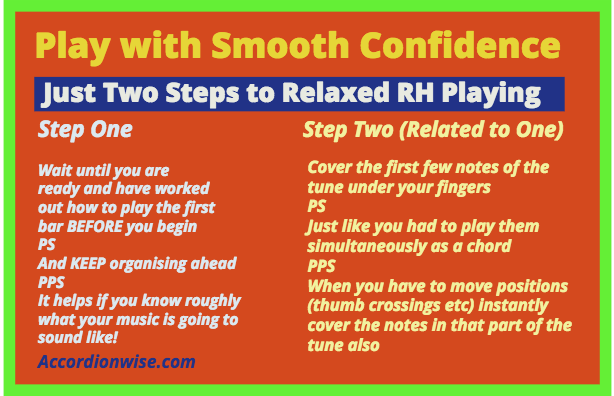
Wednesday November 21st.
THE IMPORTANCE OF AVOIDING MONOTONOUS PLAYING
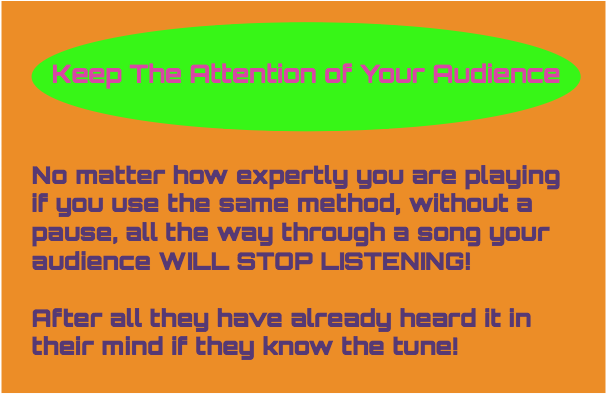
My morning inspiration is this.
MONOTONY IS THE ENEMY OF AUDIENCE ATTENTION.
However expertly you are playing if you carry on using the same method for bar after bar you will bore your audience. If they already know the tune they will know exactly what will happen till the end of the song
IT IS A STORY
You are telling them a musical story so you should add new revelations along the way and not predict the exact ending
.
These may be in the nature of different accenting, pauses, different bass runs, places where you do not play bass, or even transfer the tune to the bass momentarily.
Your phrasing may vary from line to line of the tune - that means no endless unbroken legato by the way or you may put in different variations to the tune (trills, turns, slides, thickness of harmony from right hand chords to solo melody line, bass linking runs and more)
This is even more the case in varying if treating the verse, chorus or middle eight bars of a tune in a different manner to make it stand out. But this may not be enough in itself to avoid monotony.
BONUS TIP
If you find an amazing little attention grabbing addition DO NOT REPEAT IT STRAIGHT AWAY! Just as a magician will not repeat the same trick before the same audience. Dazzle them with it and if you are going to use the same effect later introduce it when they are not expecting it!
Monday November 26th
AN EASY CURE FOR THE MOST ANNOYING SOUND IN ACCORDION PLAYING!
THE MOST BASIC WAY TO AVOID MONOTONY IN 4 Beats in a Bar SO EASY AND INCREDIBLY PROFESSIONAL SOUNDING - A FORMULA THAT I WORKED OUT HOW TO EXPLAIN THIS MORNING
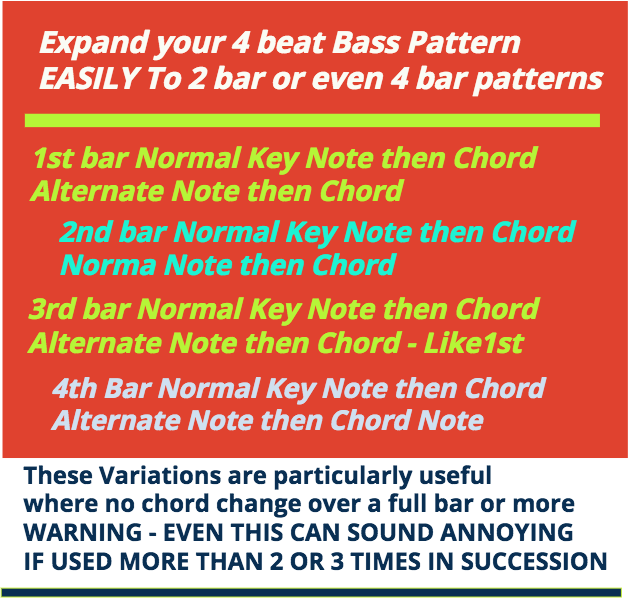
First bar is "normal" with alternate bass note between chords (e.g. alternate note is G if a C chord)
Second bar is even easier providing you have control over your left hand, you keep to the same basic key note on the 3rd beat, the key note or C if a C Chord
Third bar is just a "normal" bar with alternate bass notes
Fourth bar has just notes on the 3rd an 4th beats, most likely in the order alternate note back to key note. This makes an unobtrusive but effect lead in towards the next bar, the beginning of the next phrase.
----------------------------------------------------------
EVEN THIS CAN BE ANNOYING IF REPEATED BLINDLY ON MORE THAN TWO OR THREE SUCCESSIVE 4 BAR PHRASES - You can always come back to it later and bear in mind you go on to a middle eight or chorus with a different emphasis it will sound good with a contrasting treatment.
The fourth bar can also CUT after 1st or 2nd beat to allow the right hand to take over if the tune suggests that by starting again after the first beat of the bar
The fourth bar could also be Note chord Note-chord-(quavers, eighth notes) Note, or experiment to find your ownTRY IT ON MOST 4 BEAT TUNES FAST OR SLOW
NOTE START WHERE THE TUNE HITS THE FIRST BEAT OF THE BAR! NO BASS TILL THEN - so....
When you're Smiling (When you're - SMILING)
For me and my girl (The bells are - RINGING)
Sunny side of the street (Grab your COAT)
You can let me know your discoveries or put your queries on the matching Facebook page.
There is now a Facebook Page for the Website
I have always encouraged people to write in here to request clarification on any subject I might not have described sufficiently well. Or to suggest items that could take more development rather than just be included in lists. There might be printed music examples wanted particularly for certain ideas, or audio or video that you feel would be useful to illustrate them.
In fact, although I have received a couple of very appreciative emails about the website, no-one has asked for this or suggested more subjects they would like covered.
Facebook is of course the place where people are used to talking freely, so it may be that this would be the way forward to make sure this site is of maximum use.
The name of the Facebook page is ACCORDIONWISE FRIENDS (Do not let your spell checker turn ACCORDIONWISE into two words!)
![]()

